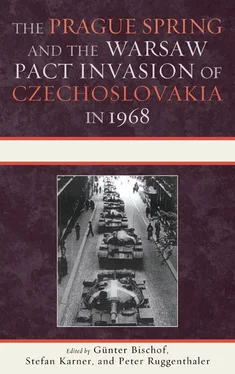In Moscow, the time had arrived to put the military option on the table openly. Brezhnev presented a written draft to the four leaders of the fraternal parties. 54He suggested installing a “red telephone” to facilitate communication between the five allies. The CPSU and the SED created a working group to monitor and analyze developments in Czechoslovakia. From May onward, the “Czechoslovak question” was on the agenda of the Politburo of the CC CPSU at least once a week. His analysis of the Politburo materials has led Mikhail Prozumenshchikov to conclude that in spite of the deterioration of the situation in Czechoslovakia the Kremlin was now inclining toward a more moderate assessment of the situation than in the spring. In his view, there are two reasons for this: on the one hand, Moscow did not want to lay itself open to the charge it was exerting “undue pressure” on Prague; on the other hand, hope was still alive that “Dubček might be induced… to impose order in the country of his own accord.” 55
Significantly, in internal discussions parallels were drawn with increasing frequency to the scenario of Hungary in 1956. KGB chief Yuri Andropov, who had been Soviet ambassador and stage manager of the Soviet intervention in Budapest in 1956, had pointed out as early as March that “methods and appearances… were strongly reminiscent of the ones in Hungary. This was what the beginnings looked like in Hungary.” The results of the abolition of media censorship in Czechoslovakia supplied Kremlin hawks such as Andropov and Ustinov with arguments and “proofs” galore that the “counterrevolution” was rapidly advancing toward its goal and that forceful measures would be required to crush it. 56
The role of the uncensored Czechoslovak mass media proved to be the greatest irritant for the Kremlin and was ultimately one of the most important factors in triggering the decision for military intervention. The proverbial last straw was the publication of Ludvík Vaculík’s “2,000 Words.” This manifesto vehemently advocated a continuation of the reforms and indeed voiced public doubts as to their viability. For the Kremlin, this marked a climax of the “counterrevolution” in Prague and signaled the beginning of the phase characterized by increasing military pressure on Prague. At the same time, options for a political solution to the crisis in the Soviet Bloc were waning, looking increasingly unrealistic. The Kremlin hawks were visibly gaining in strength. They now favored a military solution without thinking about the political consequences of an invasion. The hardliners in the fraternal parties aided and abetted their line. Seen in this light, Vaculík’s “2,000 Words” was “a proclamation of the counterrevolution.” 57
FROM WARSAW TO BRATISLAVA
Phase III began with the “2,000 Words” and was characterized by the actual military-political and operative preparations for the intervention and occupation of Czechoslovakia being put into practice. On 15 July, the die was cast for the intervention. The CPSU convened yet another meeting with the four fraternal parties in Warsaw, so there would be no lack of consultation. 58Moscow reserved the final decision as to the deployment of the troops for itself. Sensing what was in store in Poland, the Czechoslovak Communist Party leadership had declined to attend. 59The five parties sent a joint letter, the “Warsaw Letter,” to the KSČ. It contained a demand for a swift change of the reformist political course couched in the terms of an ultimatum. 60The Warsaw Five were no longer willing to credit the KSČ with having the energy needed to turn things around according to their wishes. For Zhivkov, the occupation of the ČSSR by Warsaw Pact troops was the precondition for victory over the forces of the “counterrevolution.” None of the other party leaders contradicted him; rather, Gomułka and Ulbricht joined him in clamoring for a military intervention. Ulbricht attacked Kádár in the strongest terms and declared that as far as the KSČ was concerned the Czechoslovaks were not merely guilty of “revisionism” (as Kádár maintained), but of staging a counterrevolution. “The next strike,” Ulbricht said, casting himself in the role of the prophet, “will be directed against you, against Hungary.” Brezhnev still harbored vestigial feelings of responsibility toward Dubček, “his man in Prague.” The hesitant Soviet party chief was the last one among the Communist leaders in Warsaw to advocate a more moderate course. Yet during the Warsaw meeting, the thunder of imminent military action could be heard clearly. 61
On their leaders’ return from Warsaw, the mighty Communist Party of the Soviet Union convened a plenum at very short notice. Many Central Committee members were on holiday and did not make it back to Moscow in time to attend. At the plenum, Brezhnev all but prepared the party for a military invasion, a decision that was applauded in principle by those present. However, Brezhnev, ever the cunctator on this issue, was still insisting that “before measures of last resort are taken we will exhaust all political means, together with the fraternal parties, to help the KSČ… retain and defend its socialist achievements.” 62
In view of the rapidly fading hope of the Czechoslovak Communist Party bringing about a change of course, the Kremlin intensified its preparations for military operations. On 19 July, four days after the meeting in Warsaw, the Politburo put the elaboration of the “extreme measures” at the top of its agenda. 63This was made easier for the Kremlin by the reassuring signals from Washington that were starting to arrive precisely in those days, intimating that the United States had no intention of interfering in Czechoslovak affairs. 64The following week was devoted to ongoing military preparations. On 20 July, the Soviet government dispatched a note to the Czechoslovak government protesting the criticism of the Warsaw Letter unleashed in the Czechoslovak media. The Kremlin also upbraided Prague for the inadequate security arrangements in place at the Czechoslovak-Austrian border, which it considered a threat to the security of the entire Socialist camp. On 22 July, the Politburo mandated Minister of Defense Marshall Grechko to take “measures… in accordance with the exchange of opinions at the meeting of the Politburo.” 65These measures also included political arrangements for the installation of a revolutionary government of the ČSSR after the invasion. A number of declarations and proclamations were drafted that were ultimately supposed to help legitimate the intervention after the fact.
Even at this late point in the game, Brezhnev and some in the Kremlin hesitated. 66Before the Politburo passed the final resolution to authorize the intervention, a final attempt was to be made to browbeat Dubček and the KSČ leadership into accepting a “political solution” on the basis of the Dresden demands. At the end of July, Soviet-Czechoslovak bilateral negotiations took place in the Slovak town of Čierná nad Tisou at the CzechoslovakSoviet border. Contrary to the Kremlin’s expectations, these talks seemed to hold out some promise after all. 67In the run-up to the meeting in Čierná nad Tisou, yet another meeting of the Warsaw Five in Moscow had been in the pipeline. This was canceled at short notice by the Politburo of the CC CPSU. For the first and only time in the history of the USSR, the entire Soviet Politburo ventured to go abroad across the border to the Čierná meeting. Dubček was given a very last chance to stop the “counterrevolution” himself. After the bilateral Čierná meeting in eastern Slovakia, the Warsaw Five met with the Czechoslovak Communist Party leaders in the Slovak capital of Bratislava on 3 August. The Soviet leadership felt it was important “to record the results of our negotiations with the KSČ leadership in a joint document.” This was tantamount to putting the agreements on an international basis, which was done during the Bratislava meeting: “In principle… the results of the negotiations were laid down in the declaration of Bratislava.” 68
Читать дальше












